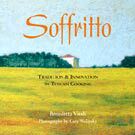|
More Mood Than Food
Soffritto: Tradition & Innovation in Tuscan Cooking
It is impossible, for instance, to forget the strangulating confines of Old Siena. Towering red brick walls loom everywhere. These keep sunlight out, tourists in, and one's sense of well-being down. As travel experiences go, visiting this hilltop redoubt of canyon-floor dwellers and otherwise dark-minded classes is akin to talking with your shrink about your mother. You learn a lot but go away depressed. Light, on the other hand – shining not upon but emerging from within things and places – tattoos Florence in mind. Her well-known beauties – the Masaccio frescoes that are more miracle than art; the monumental copy of David in the Piazza; the Duomo, cold, severe, and humbling in its scale; even the Baptistery, whose east door Michelangelo declared worthy of the gate into paradise – are all so bloomingly radiant as to render themselves cliches. This is not to say the ravishing Florentine glow fails to illuminate fresher fascinations. Take the stalwart wooden gates fronting the princely villas lining the Pitti side of the Arno. Each is pierced by a small hole and slot. To these grand townhouses of the landed nobility, whose countryside fattore grew the grapes, lesser Florentines flocked to buy wine. How much lesser? Well, sufficiently so that the gente would not permit them to pass their portals. Instead, money was anonymously paid in through the confessional slots. Wine was just as facelessly dispensed through the holes. Tuscan food is easily as primitive as, but considerably less intriguing than, ancient Florentine pumping stations. Alan Davidson diplomatically avoids characterizing it in terms of butcher's-string textures and popsicle-stick flavors. Instead, he generously describes the cuisine as "a calmer spirit than that of other Italian regions ... famed for its traditional breads and olives." These, a slab of Tuscany's milquetoast rendition of Pecorino cheese, and a fiasco of something Trebbiano-esque, make decent enough lunch fare. As for the rest of its indigenous larder – game in season, beans, salted fish, black cabbage, cardoons, pickled pork fat, grass-fed beef, leaf and root vegetables, zucchini, and nipitella (a wild herb of the mint family) - it is unarguably boring stuff, hardly the basis for a book's worth of venturesome plates. So why make a hoo-ha over the Tuscan table? For chef-author Benedetta Vitali, the attraction lies more in the mood than in the food. Tuscany, she implies, is as much state of mind as statelet of the congery that is the modern Italian union. It is province-qua-repository-of-memory-and-tradition that she endeavors to present. So lofty an approach affords plenty of opportunity for poetic culinary writing. The promise, alas, remains unfulfilled. Interested readers are left with not much in the way of repertoire-worthy recipes and even less of breathtaking (or even mildly compelling) lyricism. The most successful chapter of the book–organized under artsy-fartsy headings like "Aroma and Taste" and "Bread, Oil, and Wine" (though nary a wine pairing is seen from cover to cover) – is called "Memory & Innovation." Here she offers recipes in an interesting progression to show how classic Tuscan dishes (for instance, Tuscan spinach ravioli) evolved to become modern ones (spinach Gnudi). "Gnudi," in the Tuscan dialect, means "naked." These are ravioli without the "clothing" of pasta. "The advantage," she writes, "is that they are much quicker to make because no dough is required, but this creates some problems as to the consistency of the mixture, which must neither fall apart when put into boiling water, nor be so stiff that it becomes hard when cooked." Her directions for its preparation are clear and adequate. Other entries under this rubric traverse the routes from Cardoons with Milk to Cardoon Soufflé, and from Cauliflower with Butter and Parmesan to Cauliflower Gratin This is a well-produced book. Fifty gorgeous images, by National Geographic photographer Cary Wolinsky, add beauty and atmosphere to the presentation. One wishes Wolinsky's considerable talent had focused on more than just a handful of finished dishes. When considering whether Tuscany will prevail because of or despite Benedetta Vitali's pretentiousness, it is well to bear in mind that food has very little to do with what Tuscany is really all about. If this were not so, how to explain the hordes of pizza eaters who always seem to stand between you and what you have traveled thousands of miles to see, or the fellow who, on emerging at noon from the Brancacci Chapel, was heard to ask what sort of pasta was Dante Alighieri. February 2002
|
 There are several aspects of Tuscany that persist in memory, but food is not foremost (not even fivemost) among them.
There are several aspects of Tuscany that persist in memory, but food is not foremost (not even fivemost) among them.